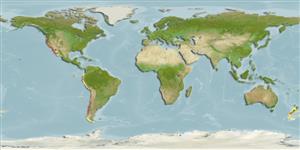Environment: milieu / climate zone / depth range / distribution range
Ecologie
marien; brak water demersaal; diepte 0 - 280 m (Ref. 34024). Subtropical; 47°N -
Eastern Pacific: Washington, USA to Baja California and Ecuador. Record from the Gulf of California is doubtful.
Grootte / Gewicht / Leeftijd
Maturity: Lm ? range ? - ? cm
Max length : 40.4 cm TL mannelijk / geslacht onbekend; (Ref. 30541); common length : 30.0 cm TL mannelijk / geslacht onbekend; (Ref. 55763)
Korte beschrijving
Determinatiesleutels | Morfologie | Morfometrie
Dorsale stekels (totaal) : 0; Dorsale zachte stralen (totaal) : 187 - 229; Anale stekels: 0; Anale zachte stralen: 150 - 181; Wervels: 86 - 91. Head naked; scales on body in basketweave pattern; precaudal vertebrae 18-19; swim bladder in males with posterior opening; body and head with numerous dark spots and blotches (Ref. 34024). Branchiostegal rays: 7 (Ref. 36413). Pelvic fin consists of one ray with two branches of unequal length (Ref. 36413).
Uncommon species found on sandy bottom from the shore to 280 m (Ref. 34024). Adults often burrow tail-first in sand, live in mucus-lined holes (Ref. 2850), mud, eelgrass and rock rubble (Ref. 36413). Mostly active at night and on overcast days (Ref. 2850). Important food for sea lions and cormorants (Ref. 2850). Oviparous, with planktonic larvae and extended pelagic juvenile (Ref. 36413). Oval, pelagic eggs float in a gelatinous mass (Ref. 205).
Nielsen, J.G., D.M. Cohen, D.F. Markle and C.R. Robins, 1999. Ophidiiform fishes of the world (Order Ophidiiformes). An annotated and illustrated catalogue of pearlfishes, cusk-eels, brotulas and other ophidiiform fishes known to date. FAO Fish. Synop. 125(18):178p. Rome: FAO. (Ref. 34024)
Status op de Rode Lijst van het IUCN (Ref. 130435)
Gevaar voor de mens
Harmless
Gebruik door de mens
Visserij: van geen belang
Tools
Speciale rapporten
Download XML
Internetbronnen
Estimates based on models
Preferred temperature (Ref.
123201): 9.3 - 15.1, mean 11.3 °C (based on 51 cells).
Fylogenetische diversiteitsindex (Ref.
82804): PD
50 = 1.0000 [Uniqueness, from 0.5 = low to 2.0 = high].
Bayesian length-weight: a=0.00102 (0.00046 - 0.00225), b=3.06 (2.88 - 3.24), in cm total length, based on all LWR estimates for this body shape (Ref.
93245).
Trofisch niveau (Ref.
69278): 4.1 ±0.57 se; based on food items.
Generation time: 2.9 ( na - na) years. Estimated as median ln(3)/K based on 1
growth studies.
Weerstandsvermogen (Ref.
120179): Gemiddeld, minimale populatieverdubbelingstijd 1,4-4,4 jaar (K=0.3).
Fishing Vulnerability (Ref.
59153): Low to moderate vulnerability (32 of 100).
